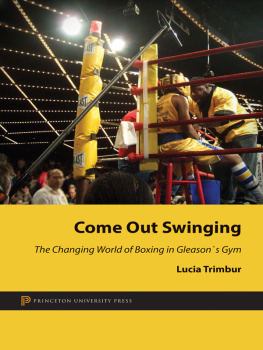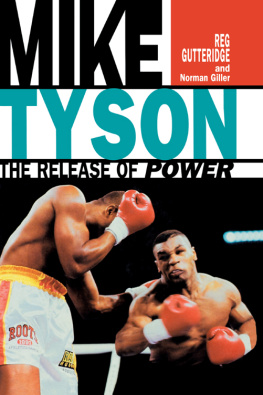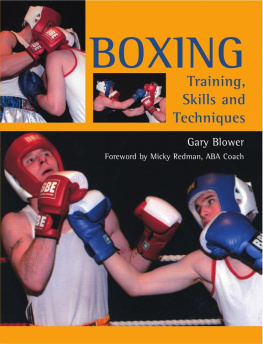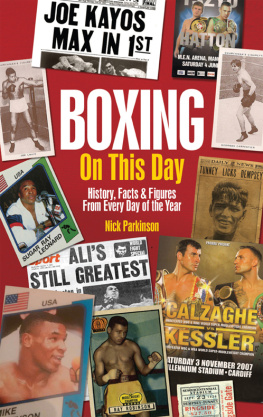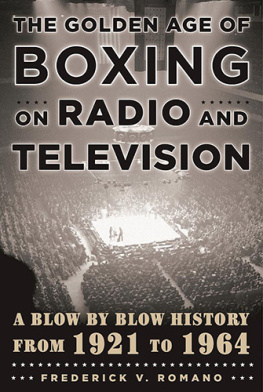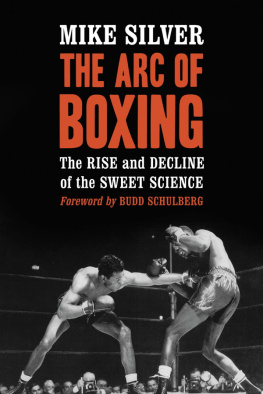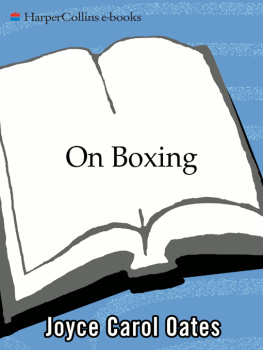
COME OUT SWINGING
COME OUT SWINGING: THE CHANGING WORLD OF BOXING IN GLEASONS GYM
Lucia Trimbur
PRINCETON UNIVERSITY PRESS
Princeton and Oxford
Copyright 2013 by Princeton University Press
Published by Princeton University Press, 41 William Street, Princeton, New Jersey 08540
In the United Kingdom: Princeton University Press, 6 Oxford Street, Woodstock, Oxfordshire OX20
1TW
press.princeton.edu
Cover photo by Issei Nakaya
All Rights Reserved
Library of Congress Cataloging-in-Publication Data
Trimbur, Lucia, 1975
Come out swinging : the changing world of boxing in Gleasons gym / Lucia Trimbur.
pages cm
Includes bibliographical references and index.
ISBN 978-0-691-15029-1 (cloth : alk. paper) 1. BoxingNew York (State) New YorkHistory. 2. GymnasiumsNew York (State)New YorkHistory. 3. Athletic clubsNew York (State) New YorkHistory. 4. Boxers (Sports) New York (State) New YorkHistory. 5. Brooklyn (New York, N.Y.) History. 6. Brooklyn (New York, N.Y.) Social life and customs. I. Title.
GV1125.T75 2013
796.8309747dc23 2012049335
British Library Cataloging-in-Publication Data is available
This book has been composed in Sabon LT Std
Printed on acid-free paper.
Printed in the United States of America
10 9 8 7 6 5 4 3 2 1
Boxing is a Combat, depending more on Strength than the Sword: But Art will yet bear down the Beam against it. A less Degree of Art will tell more than a considerably greater Strength. Strength is certainly what the Boxer ought to fet [sic] out with, but without Art he will succeed but poorly. The Deficiency of Strength may be greatly supplied by Art; but the want of Art will have heavy and unwieldy Succour from Strength.
CAPTAIN JOHN GODFREY, 1747
This is boxing. This is the new boxing.
MIKE SMITH, 2004
To
Harry and Mike, for caring when no one else does
and
Nelson, for caring unconditionally
Contents
Acknowledgments
When I wrote the acknowledgments for my dissertation, a historian friend joked that they were almost as long as a chapter. But while doing their research and writing, ethnographers rely on so many people, and incur so many personal debts along the way, that many people need to be recognized. This book is no different.
I benefited from financial support from a number of sources, which helped me conduct research and prepare this book. At Yale University, multiple Camp Research Fund fellowships and a University Dissertation Fellowship provided me with funding to perform ethnographic research. A Beinecke Rare Book and Manuscript Fellowship gave me five months of archival research on boxing training manuals from the eighteenth, nineteenth, and twentieth centuries. As an Andrew W. Mellon Postdoctoral Fellow on Race, Crime, and Justice at the Vera Institute of Justice, I enjoyed precious time to think through the manuscript and play around with different ways of organizing my thoughts. At John Jay College and the City University of New York (CUNY), several awardsa PSC-CUNY award, a Special Research Fund grant, a Research Assistance Program grant, and a Faculty Fellowship Publication Program awardprovided me with course releases to research and write, forums to workshop my writing, and research assistance.
This project would have been impossible without the endless hours Harry Keitt and Mike Smith spent with me. For over a decade, Mike and Harry have given me data about boxing and, more important, about life. I cherish their friendships, and I deeply appreciate the counsel they have provided me. I am in great debt to the boxers of Gleasons Gym, whom I cannot mention by real name, but whose generosity of spirit, sense of purpose, aspirations, and daily struggles are on my mind every day. I give countless thanks to Gleasons trainers, who spent a tremendous amount of time explaining their craft to me, providing me with unguarded access to the good and bad in their lives. And I extend my warmest gratitude to Bruce Silverglade for making Gleasons Gym my second home. Bruce gave me unfettered access to the gym, and I still miss spending my days there.
Josh Gamson and his Participant Observation class at Yale University, Steven Gregory and his Epistemology and Politics of Ethnography class at Columbia University, and Mitch Duneier and his Urban Ethnography class at CUNYs Graduate Center facilitated thoughtful discussions on the practice, politics, and poetics of ethnography. Each class had a different perspective, and each helped me think about ethnography in new ways. Mitch, in particular, got me writing when I felt stuck.
My writing groupColin Jerolmack, Jooyoung Lee, Erin OConnor, Harel Shapira, R. Tyson Smith, and Iddo Tavoryhas been invaluable in the production of this book. The group gave me beautifully detailed feedback that sometimes confronted the limits of my intellectual capabilities. I have learned so much from my ethnographic comrades and their work, and I always look forward to our meetings. Tyson and Harel, in particular, have closely watched this text come to life, and I am moved by their kindness. Participating in Columbia University/New York Universitys Craft of Ethnography Workshop under Sudhir Venkateshs direction and the University of Pennsylvanias Urban Ethnography Workshop under David Grazians leadership provided me with crucial insights. I also heartily thank Paul Willis and his Claims and Evidence class at Princeton for smart and intriguing questions and comments that helped me refine . And immeasurable gratitude goes to Lewis Gordon and the members of the Humanities Center at Temple University, especially Heath Fogg Davis, for their engaged contributions.
Email exchanges with Loic Wacquant clarified analytical points related to boxing and boxing gyms. I value the time Loic spent reading my work, challenging my conclusions in detail, and suggesting readings. Eric Raskin, then an editor at Ring Magazine and a boxing expert, suggested I choose Gleasons Gym to do my research in the first place; this project literally would not have happened without Erics recommendation. I thank Hilary Silver for being a steady and dependable source of ideas and camaraderie for the past twenty years. I also thank Gunther Kress for all that he has taught me and for his belief in me as an academic. And I appreciate the late Jeannette Hopkins for teaching me about the world of publishing.
It is hard to say enough about Paul Gilroy and Vron Ware. From the bottom of my heart, I thank them for providing me with safety under their collective wings. For more than a decade, they have gently challenged me and fiercely supported me. I have found peace inside and outside academia because of them. I have benefited immensely from the advice of Alondra Nelson and Rachel Sherman, and I treasure their friendship.
I am grateful to friends and colleagues who read parts of the book or provided other forms of input and critique. Shamus Khan and David Grazians meticulous and astute comments helped me turn these chapters into a real book. I give them special thanks for contributing their expertise when I know they were busy. Ronald Kramer spent an incredible amount of time helping me improve this manuscript; somehow Ronald could always find a cogent idea in my muddled thoughts. Michael Driscoll read everything line by line, correcting my many mistakes and challenging me to produce a better, more accessible text. Michael Aiello, Aisha Bastiaans, Georg Bauer, Cassie Hayes, David J. Leonard, Theresa Runstedtler, and Michael Yarbrough stepped in to give me feedback and quell anxiety in the final moments of writing. My colleagues at John Jay College recommended readings, commented on my writing, and generally gave me direction when I felt lost. I thank Amy Adamczyk, Michael Blitz, Dave Brotherton, Janice Johnson Dias, Joshua Freilich, Robert Garot, Amy Green, Richard Haw, Lila Kazemian, Rich Ocejo, Susan Opotow, Jay Pastrana, Valli Rajah, Theresa Rockett, and Fritz Umbach. I am fortunate to work with brilliant and generous students, especially Michael Aiello, Alex Harocopos, Bobby Smith, Michael Sullivan, and Alex Tejada, who teach me something new each day while keeping me on my toes. My thanks also to Lynn Chancer and the members of the CUNY Faculty Fellowship Publication Program, especially Leigh Jones, as well as Tina Chiu, Zaire Dinzey-Flores, Michael Jacobson, William Kornblum, Mike Smith, Jim D. Taylor, and Jon Wool.
Next page
